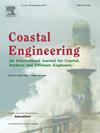Energy balance during Bragg wave resonance by submerged porous breakwaters through a mixture theory-based δ-LES-SPH model
IF 4.2
2区 工程技术
Q1 ENGINEERING, CIVIL
引用次数: 0
Abstract
This paper presents a numerical analysis of the time behaviors of mechanical and internal fluid energies during the Bragg wave resonance induced by two-arrayed trapezoidal submerged porous breakwaters based on a reformatted δ-LES-SPH model (Di Mascio et al., 2017). In the present work, a mixture theory is introduced into the δ-LES-SPH model by reformulating the governing equations with the incorporation of a volume fraction. In this approach, the viscous and diffusive terms are also modified by the volume fraction. The energy equation is then written for the presented model highlighting the presence of two additional components compared with the classical δ-LES-SPH formulation: one coming from the fluid compression and another one due to the dissipation both induced by the interaction of the porous structure with the fluid phase. The numerical results are validated by available experimental data for a gravity-driven mass flow passing through a porous dam case and two Bragg wave resonance by two-arrayed submerged trapezoidal porous breakwaters cases. A numerical analysis is then conducted on Bragg wave resonance by two-arrayed trapezoidal porous breakwaters, by investigating the effects of the distance between the two breakwaters and their porosity. Interesting insights about the type and magnitude of dissipation occurring during the wave-structure interaction are captured by analyzing the time evolutions of each energy component.
通过基于混合物理论的 δ-LES-SPH 模型计算水下多孔防波堤布拉格波共振时的能量平衡
本文基于重新格式化的δ-LES-SPH 模型(Di Mascio 等人,2017 年),对双列梯形水下多孔防波堤诱发布拉格波共振期间的机械能和内部流体能的时间行为进行了数值分析。在本研究中,通过将体积分数纳入控制方程的重构,将混合物理论引入了 δ-LES-SPH 模型。在这种方法中,粘性和扩散项也会因体积分数而改变。与经典的 δ-LES-SPH 公式相比,所提出模型的能量方程突出了两个额外部分的存在:一个来自流体压缩,另一个来自多孔结构与流体相相互作用引起的耗散。数值结果通过重力驱动的质量流通过多孔坝情况下的现有实验数据和双列浸没式梯形多孔防波堤情况下的两个布拉格波共振进行了验证。然后,通过研究两个防波堤之间的距离及其孔隙率的影响,对双列梯形多孔防波堤的布拉格波共振进行了数值分析。通过分析各能量分量的时间演化,我们获得了有关波浪与结构相互作用过程中发生的耗散类型和大小的有趣见解。
本文章由计算机程序翻译,如有差异,请以英文原文为准。
求助全文
约1分钟内获得全文
求助全文
来源期刊

Coastal Engineering
工程技术-工程:大洋
CiteScore
9.20
自引率
13.60%
发文量
0
审稿时长
3.5 months
期刊介绍:
Coastal Engineering is an international medium for coastal engineers and scientists. Combining practical applications with modern technological and scientific approaches, such as mathematical and numerical modelling, laboratory and field observations and experiments, it publishes fundamental studies as well as case studies on the following aspects of coastal, harbour and offshore engineering: waves, currents and sediment transport; coastal, estuarine and offshore morphology; technical and functional design of coastal and harbour structures; morphological and environmental impact of coastal, harbour and offshore structures.
 求助内容:
求助内容: 应助结果提醒方式:
应助结果提醒方式:


